|
Interview by Juanita Canzoneri Deb Hager joined Commonwheel about the same time as the floods hit Manitou Springs in 2013. She had been in Green Horse Gallery in Manitou Springs prior to applying to the co-op. As a child Deb was always playing in the dirt around her home. The neighborhood of Penn Hills outside Pittsburgh, PA was under construction so there were dirt piles everywhere. “I had the most gracious mom. I’d be out playing in the dirt, making swimming pools for my Barbies. And when it was time to come in for lunch, she’d just hose us off, we’d eat lunch, and then we’d go back out to the dirt piles.” Deb attended Indiana University in Pennsylvania as an art major. Her passions were for drawing and painting. When she had to take a 3-D class she took a clay class and wasn’t very happy about it. “I kept practicing and practicing, and I was the worst one in my class,” Deb says. “Everyone else was centering (their wheel-thrown pots), but me.” One day she was so frustrated with her progress the professor found her crying in her clay. He was able to show her where she had been getting stuck and, with that guidance, she just took off. “Because it didn’t come easy to me, because I had to work so hard at it” she says, “I kind of fell in love with it.” Once she learned wheel throwing, she became mesmerized by the whole process. “You have this nothing lump and then you make this something that people are using.” Deb’s husband, Denver, was in the military and wherever they were stationed she would teach classes in ceramic shops and teach art lessons just to keep her hand in it. When they moved to Colorado in 1995, she became a wheel-throwing potter at Van Briggle. That’s where she began developing her own style of work. Until then her pots were plain and undecorated. In 2007 their youngest child was a senior in high school. Denver mentioned to Deb that she had money from the military to use to go back to school herself. While looking for schools she attended the National Council on Education for the Ceramic Arts (NCECA) convention for the first time. At that convention she fell in love with soda firing and knew at that point she needed leave Van Briggle and go back to school. While she was training her replacement at Van Briggle, she learned about the ceramic program at Colorado State University in Pueblo. One of the courses of study they teach is soda fired ceramics. So that was where she decided to go. But her fear of the computer hindered her from enrolling. So, Denver called the college and had one of the professors talk her through the enrollment process. Denver then helped her with her military paperwork and financial forms while her children taught Deb basic computer skills. So just getting her into college was a family affair. And they did it all in less than 6 months. “It was one of the greatest gifts of my life. It did things for me that I would never have believed It could do for me.” While working with the other students she realized what she wanted to do was draw and paint on her pots. She enjoyed drawing and painting for years and wanted to add that to her pottery. And she noticed another student scratching into his pots, and she added sgrafitto (incised or scratched lines) to her designs. One of Deb’s long-standing designs is her dragonfly pottery. She adds the dragonflies, always in pairs, to the raw pottery pieces before they are bisque fired using black underglaze and a bamboo brush. She has the design down to 7 strokes per dragonfly—the 4 wings, the body, and the 2 eyes. She hasn’t varied her technique because it takes her back to her early love of calligraphy. Once the piece is bisque fired, she puts a wax resist on the dragonflies and glazes the piece. In the final firing the wax resist burns off and the dragonfly texture stands in contrast to the gloss of the glazed surface. Deb makes her own glazes and enjoys the excitement and mystery of mixing the tactile ingredients that will become colors and textures on her finished work. “There are so many talented potters in this area. I realized I needed to make glazes that are different from everyone else’s.” She’s worked hard to steer her color palette so that it is unique to her work.
0 Comments
For “Garden Art” we put out a call looking for Commonwheel Artists Co-op is seeking submissions for artwork with either a garden theme or be work that could be placed in a garden. We got 26 applications and accepted work from 20 artists. We asked these artists some questions to help you get to know them a little better. Below are their responses to these questions: 1) In a short paragraph, tell us about yourself (How did you get interested in art, your art work/medium of choice, etc.). 2) With your art, tell us about your process. Walk us through the steps achieve one of your pieces. (Please provide photo of yourself working on piece if available). 3) What is your favorite piece accepted for this event? Why? (Please provide a photograph of the specific piece you are referring to). 4) What has inspired you to apply for this show? 5) Where can we find your work: website, social media, local galleries. Deb Bartos I enjoyed painting as a child in school and won awards, scholarships, etc. I picked it up again as an adult after the death of a close friend as a way to reconnect to life and beauty. I had seen some beautiful art shows here in town and wanted to connect to the feeling they conveyed. Then once I started painting, it was compelling, and I knew I wanted to continue. I usually paint outdoors on location (plein air) or rarely if not possible due to location or size, work to incorporate the same freshness in my work. The feeling of being in a place adds to the experience and I believe shows in the finished piece. Hard to pick a favorite, because with each one I'm learning and pushing the envelope. I guess my favorite is because of the place and connection, poppies in Ernest Blumenschein's garden in Taos is a magical and historical place. The rest also have special memories of time and place as well. I like the theme of garden art, and after a season of nature's winter palette, am always excited to be able to share beautiful bright colors of the garden. Gardens are a place of peace for me, and connection to the earth, our home. My work can be found at my website www.DebBartos.com, my Facebook page Deb Bartos Fine Art, also Wooglin's Deli in Colorado Springs and the Sangre de Cristo Three Peaks Gift Shop in Pueblo, CO Ben Bires My grandmother was an artist and has been my inspiration to pursue art. At an early age. I began to appreciate nature as I was surrounded by her paintings of wildlife scenes that would cover her entire garage, basement and random objects around the house such as chairs and the refrigerator. Ever since a Geology professor took a group of students and I to the Badlands National Park in 2011, I have been fascinated with the way wind and water sculpts the land. I have worked with oils, watercolors and pencil drawings but recently have been enjoying the versatility of acrylics. My process begins with a thick layer of color for the undertone. The blue sky comes next followed by a chalked-in red rock design. With a focus on the intense shadows, I mix deep purples for the darkest tone and gather a few shades of red. Using the gel medium retarder helps to slow down the drying process, which allows me to treat the paint like oils. glad this one was chosen because it’s the first rock structure that makes you feel small on your drive into the park. As you approach South Gateway Rock, you realize how big these things are. I fell in love with the contrast between red rocks and blue skies after moving to Colorado Springs in 2016. I do love gardening, but since I live so close to Garden of the Gods, I feel the need to show my admiration for these remarkable formations. Taking walks through such vast open spaces motivates me to express my interpretation of the landscape. www.BenBires.com Facebook - @BenBiresArtwork Instagram - @benbires37 Marsha CM Blasgen My earliest memory of making art was illustrating and dictating a story at about 3 years old. I have worked as a commercial artist, designer, printmaker, landscape painter, scenic design and stage make-up artist. Also, I have been a public-school art teacher for a number of years. Now my main interest is painting. Flowers are always a delight. I love looking at the blossoms in the morning sun, and I used photos for the acrylic paintings taken at that time. The two acrylic flower paintings are in-depth studies, more like portraits. Usually, I have a visual image in my head to launch my artwork from. This time, the two acrylics were painted as isolations of specific light against deep shadow. Colors were chosen as close to what I saw as I could translate into paint. Simplifying the composition and the content was important to me, allowing my focus to direct the audience’s focus more easily. The background was painted first, after the flowers were sketched in place in pencil. The flowers were then painted using the deeper saturated colors first. Lastly the edges are refined, and the brightest lit areas were finished. The watercolor was painted when a Colorado spring frost hit my poppies at full bloom. I brought the poppies into the studio and just painted the character of the stems and their blooms quickly on dry watercolor paper After a quick, light pencil sketch of the shapes, I mixed the watercolors on pans, matching them to the real flowers. Then just painted the flowers. Spring Dance is my favorite of the three in this exhibit. I saw them as dancing in the extremes of weather, their stems bending with the forces of warm sun and chilling frost. The fragile petals, so brilliant and fading quickly caused me to just paint and not think. The theme is about one of my favorite things- plants. I like to exhibit in shows that celebrate living with and enjoying nature. Gardening has always been a part of my life, making this a fun exhibit to paint for. Marshamillspaughblasgen.com MarshaCMBlasgen (facebook); Marsha Blasgen, (facebook); Beausarts (instagram) Kristin Colvin I have always loved art and starting painting full time a few years ago. I started with watercolors and loved to see the colors mixing on the paper. Acrylics and alcohol ink are newer mediums for me. Each have beautiful color combinations to explore. After deciding on the subject for a watercolor painting, briefly sketch layout, then Misket areas to remain white or a solid border if a background wash is used. Botanical style flower paintings may need many layers to express the minute details of the flowers. My favorite piece is the tulip botanical. They are my favorite flower, and this was my first painting of tulips. I was inspired to enter this show because of my love of gardens and flowers. Flowers come in such happy colors. I am always amazed at the beauty of nature and am inspired to try to capture it. Currently show year-round at Febra’s, 2532 W Colorado Ave., in Old Colorado City. Also do various craft shows each fall, email for list of shows [email protected] Deb Hager I have always loved playing in mud …and string mixing things as a child. I took pottery in college at Indiana University of PA., it was quite challenging to learn to center the pot on the wheel. Once I learned to center the clay I was hooked. I worked as a potter for Van Briggle for several years, where I learned to perfect my throwing skills. At Van Briggle we had several designs that included flower frogs and floral arranging. I loved the contrast of the ceramic vessel with the variety of clay colors. I have developed my own Ikebana design. I enjoy the simplicity of the Ikebana floral arranging. I throw each Ikebana on the wheel then Bisque fire each piece. I add the Dragonfly using a Bamboo brush, or each Ikebana is glazed in a solid color. The Dragonfly pieces are my favorite, I like the combination of Dragonflies and Flowers. www.claybynature.com m jo hart Originally from St. Louis, I moved to Colorado in 2015 after receiving my MFA in Ceramics from Illinois State University. I have a B.A. in Visual Communications and have worked as an Art Director/Graphic Designer in the corporate sector, non-profit, and public/private design industries with over 38+ years. I consider myself both an artist and maker. I create highly decorative functional pottery along with sculptural work that primarily focuses on female issues. During my time as a designer I sought out ways to create for myself and was reacquainted with clay, remembering the fun I had in the clay studio as an undergrad. For years I attended classes at a local pottery studio and began selling my work. Later in my life an opportunity to apply to graduate school presented itself and I fully immersed myself in a 3-year program where I discovered a passion for working with the figure in clay, primarily on female issues. Attending graduate school as an older student, I was confronted with many hurdles and I was presented with countless opportunity for evolving as an artist. Today, I work as an artist/maker, leaving the corporate world in the dust and no longer having to be contained in a cubicle. Recently I began collaborating with my partner, combining his woodworking craft and my porcelain art. I teach workshops and private lessons in clay and other mediums and find the creative process at times more satisfying than the outcome. As a self-supporting artist my piggy bank is often not as full as it was, but I wouldn’t trade this life for anything. Showing in “Garden Art” gives me an opportunity to stretch a little as an artist. I am making large ceramic flowers, birds and butterflies on metal stakes to place in the yard or display inside when the weather gets near freezing. Some are enlarged imitations of the real thing and others are fun imaginary creations. I have also collaborated with my partner in making the ceramic planters and he has made the colorful wood stands. They are bright, whimsical and something you won’t find at the garden store. My ceramic work can be found at Commonwheel Artist Co-Op and I can be reached at my email address; [email protected] and my Instagram is @johartart. Jennifer Hanson I love the immediacy of the clay, the physical nature of the work, and the mind-body connection. I can go into the studio with a new idea and try it out right way. Whether it’s a new throwing technique, a slab idea, or making beads, I can start working out the problems right away. The versatility of clay lets me express my various interests. I have several running themes in my art that I explore. I prefer to work in small series or batches, exploring the theme, then returning to it later when inspiration has struck again. This keeps my work fresh and unique, and I always get a surprise when I open the kiln! The pieces in this show were made with flowers from my garden. I used a rolling pin to impress them into the clay. I like to think of them as botanical prints. I stain the flower imprint to make them stand out then fire them in a kiln. I love the mica clay because it gives some flower "bling". I like all the pieces created for this show. The call for this show was directly related to the kind of pottery I like to make. spinningstarstudio.com fb and instagram: Spinning Star Studio Green Horse Gallery Colorado Fine Artworks Colorado Springs Pioneers Museum Cottonwood Center for the Arts Christopher Hureau I’ve been an artist all my life, and professionally for over 30 years as an Illustrator and Graphic Designer. I was the Senior Illustrator at the Air Force Academy for 17 years until 2013 where I was able to use my traditional painting skills, as well as digital illustration and graphic design. My greatest desire, however, was to devote my entire time to oil painting, especially landscapes and cityscapes. My painting process is very methodical owing to my experience as a commercial illustrator. At this time, I am strictly a studio artist, as the level of detail in my work requires extensive time. I used photo reference, but my rule is that I only use photos that I take of places I experience first-hand. My painting approach is traditional, first “blocking in” the canvas totally, then incrementally building up the detail. One piece was accepted for this show, but I did enjoy painting the scene. It’s a combination of nature and man-made subjects. The garden theme was a good fit for some of my best pieces and it serves to introduce my work to the Commonwheel Gallery and their patrons. My website is Hureau-art.com and my Facebook name is Christopher Hureau Art. At this time, I have over a dozen original paintings in the Gold Hills Mesa Gallery. Prints of my original art can be purchased through my website and can also be found at the Garden of the Gods Trading Post and the Air Force Academy Gift Shop. I also exhibit works at numerous shows throughout the year. Last year these included the Mueller State Park Show and the Florissant Fossil Beds National Park Show, as well as the Colorado College Holiday Arts and Crafts Fair. Jacqueline Keller I have been an artist my whole life. I am from Chicagoland where my grandmother, Florence Keller, was an artist, gave art lessons and let us kids have free reign of her studio. She most often painted watercolors outdoors in our yard, at lakes, and area forest preserves, and that is how I learned to paint. My day job is a librarian at the West Custer County Library in Westcliffe. I have no steadfast rules for how I begin. Sometimes I start with ink, sometimes with paint. I got past any pencil sketching a long time ago and jump right in with ink and paint. I lay out the background and start to add the details. Each scene presents itself in its own way. My most comfortable scenario is painting outdoors, rural or urban landscapes and cityscapes - I like both. I am most comfortable with plein air competitions when those come around, and I can squeeze them into my schedule. The piece accepted for this show was done in the studio. Last fall I had a bumper crop of gorgeous Calendula, my kitchen was full of flower heads for oils and salves, and I could not resist painting it. Calendula was a larger piece than I usually do and sat unfinished all this time. I was inspired to finish it because of this show. Thanks for that. I currently have art at Greenstone Artworks, 110 Main Street, Westcliffe, CO 81252. I also regularly show at 3rd St. Gallery, 59000 N. Hwy 69, Westcliffe, CO 81252 and The Bell Tower, 201 E. 2nd St., Florence, CO 81226. I have a Facebook page - just me, Jacqueline Keller. Nina Kuberski It all began in the backyard with a recipe book for mud pies when I was five years old. I would bring home raw clay from dry river beds and let the book be my starting point for the most inedible mud pies you’ve ever seen. Then there were doll lamp shades made from cupcake liners, spools, and pipe cleaners. I’ve always had to keep my hands busy. I work with window glass, fusible glass, fabric, yarn, wire, clay, most anything that is laying around in the studio. The mushrooms are made from window glass or fusible glass attached to PVC. The glass is cut to the proper diameter, decorated with glass powders and frit, then fired in the kiln just long enough to make everything stick together. Then the mold is put into the kiln with the glass ready for draping. It always seems like magic when opening the lid for the final time. I hate to play favorites; the honey bee magnets are my current favorite. Honey bees are important to our food supply and they make me smile. The magnets will hold up at least 2 sheets of paper. I’ve long known of the devoted customer base that Commonwheel has. Hopefully the customers will come to love my varied artwork. Marta Lacombe In my jewelry art I started using small objects that could be repurposed, using them as a central theme of my jewelry art. My husband, a native of Colorado Springs, is a lover of the wild, an avid hiker, and my best supplier of metal, scraps, pieces of wood, broken glass and aged rusted objects. He finds new possibilities everywhere he goes and brings home lots of things. It so happens that some pieces that my husband brings home are too large to hang on necks or ears!! So, I started making larger pieces experimenting with a lot of different media. My pieces combine a variety of media, depending on the inspiration I find in the objects with which I start. I add glass beads, wire wrapping, other metal findings. The results are interesting and unique, and no two pieces are exactly the same. My favorite piece for this show is the Insulator Art – Blue in Blue. I had this painted piece of 2 by 4 for a long time sitting at a corner of my studio. I always like the color of it and the way it was peeling and aged. I love insulators – the thick glass, the slightly different shapes, the many colors and materials. My husband found in his grandpa’s many storages a box full of insulators. And in the box, a blue one the same tone as the piece of wood! From then it was easy! My inspiration came from the color and wanting to use the insulators as vases for small plants. I also used a piece of barb wire I had saved for a next piece of jewelry, but it was too large. This show’s call for artists was published at the time when I had 2 pieces for my outside patio in the works – so I thought it was a “sign” and applied to the show. I currently do not have any larger piece on my website or Etsy store; I have not been able to maintain a stock inventory! Website – www.jewelrybymana.com Instagram - https://www.instagram.com/jewelrybymana Etsy store - https://www.etsy.com/shop/JewelrybyMana Kuttlefish store - https://kuttlefish.com/shops/jewelrybymana Susan Marion Art has been a natural and important part of who I am ever since I could hold a crayon. Pretty early on, in high school, I felt a connection to watercolor, which has been my one and only medium for over 45 years. My representational work starts with photographs I take. I look for unique moments when everyday objects or scenes are captured in just the right light and composition. The “unforgiving” nature of watercolor (no do-overs!) means that I spend a lot of time planning the composition and thinking “ten steps ahead” before putting brush to paper. Being self-taught, I take an intuitive approach to the painting process, rather than follow more traditional procedures. My favorite piece in the “Garden Art” show is “Columbines”, because it has the most “movement”. Of all the paintings I’ve done of flowers, it reminds me the most of “dancing”, and somehow gives me a sense of having a “magical” quality that I love! I was inspired to apply for this show in particular, because close-ups of flowers has been the primary focus of my work for the past two years. Flowers are my “thing”. I recently found this quote by Georgia O’Keefe: “I decided that if I could paint that flower in a huge scale, you could not ignore its beauty.” My work can be found online at peakradar.com (Visual Artists’ Profiles), and at themountainartists.org., and also will be exhibited at these locations: May 1 – June 1, 2018 Art on the Mesa Gallery at Gold Hill Mesa, 142 South Raven Mine Dr., Colorado Springs, CO 80906 May 1 – July 1, 2018 The Gallery at Rampart Range Library, 218 E. Midland Ave., Woodland Park, CO 80863 May 12 – June 27, 2018 Colorado Watercolor Society State Watercolor Exhibition, 21c Library, Pikes Peak Library District, 1175 Chapel Hills Dr, Colorado Springs, CO 80920 May 29 - June 22, 2018 Palmer Lake Art Group “Color Splash” Show, Tri-Lakes Center for the Arts, 304 Hwy. 105, Palmer Lake, CO July 1 – Aug 1, 2018 The Eichman Gallery at Park State Bank, 710 West US Hwy 24, Woodland Park, CO 80863 Aug. 4 – 5, 2018 Mountain Arts Festival, Woodland Park, CO 80863 Marla Sullivan “As a child, I was preoccupied with drawing and dreaming. My dreamscapes have always been dominated by the wonder of shapes, something that remains a big part of my work.” The paintings of Centennial artist Marla Sullivan, who studied with Milton Glaser at the School of Visual Arts in New York and later earned a BFA from Metropolitan State College of Denver, are a mix of representational and impressionistic techniques that convey an energy that is irrepressible. Her whimsical Universal Villages series is painted on cedar shake roof shingles. The long, narrow planks feature dynamic brushwork and incorporate decorative paper, tile, glass, and found objects. “My Universal Villages series is my tribute to enchantment and color. I want my viewers to have fun with a piece, to feel lighter when they experience what I have created, and to reflect on all that is good in life. My art is reasonably priced, so collectors can enjoy a fun, original work of art in their home.” MarlaSullivanArt.com Susan Tormoen My education is in philosophy, BA Lake Forest College. Early on when I was finishing my studies as a young mother I took a few art classes. For years I concentrated on watercolor but after moving from Wisconsin to Colorado I became enamored with pastel. It was then that spontaneity became characteristic of my style. The piece I entered is not a good example of my usual style. But I love color and the way it is possible with the stroke of a pastel stick. Recently I renewed my acquaintance with oil and the pallet knife is usually the instrument of choice. I'm represented by the galleries: Fare Bella in Manitou and Boulder Street in Springs. And right now, am showing at the Hanson Gallery at Cottonwood. My work is on Fineartamerica, Artpal and Faso. Am a member of Colorado Spring Art Guild and a signature member of Pikes Peak Pastel Society. Joan Tucker My name is Joan Tucker. I have lived in Colorado Springs for 21 years. I have loved art all my life. I started by painting ceramics and then tole painting. I am pretty much self-taught. Nothing ever came naturally, but I love to paint. Art is my therapy. My inspiration comes from nature and travel pictures. I have found that I love painting old buildings in nature. I prefer acrylic paints because it's easier to fix my mistakes. I tried for this show to see if anyone else thought I could paint even a little. I don't have any social media. Leti Wesolowski
I got interested in jewelry making by chance while trying to find something to fill my spare time. Back then I was going to college to get certified as architectural drafter and working full time. Still I found time to take a few art classes and practiced some basic jewelry techniques to adorn myself. It didn’t take long for friends and coworkers to ask me to make special orders for them, so eventually I got busy making jewelry, I quit my full-time job and I started my own small business. Drawing and painting have come naturally since I was young. My father introduced me to oil painting when I was 11, and soon after gave me a camera that I took everywhere. My mom taught me knitting and crochet and I embroidered my cloths and made friendship bracelets. In my teen years I kept painting, and pencil drawing-- landscapes, pet portraits and Christmas cards for my family. I dabbed in many other crafts and participated at art shows and competitions. Jewelry making has been a learning experience and quite an amazing journey these past 14 years. I had played with a variety of techniques, including silversmithing, but I always enjoyed wire wrapping the most. Today you can explore my collection, all one-of-a-kind and entirely made by me using mostly wire wrapping in silver, gold and copper, in combination with crochet, macramé, braiding, and metal forging techniques. Although the design I made for this show uses wire, is not technically wire wrapping, it is more wire “twisting,” in which beads are attached and spaced twisting sections of wire and creating branches. This is one technique I played with long time ago and now I am discovering it again with fresh eyes. Each show brings the possibility to explore new ideas, so for the “Garden Art” show I wanted to bring a little bit of Mother Nature into my jewelry creating something resembling a blooming tree in Spring. For my favorite piece I picked golden pearls, seed beads, and crystals in a beige palette, and although simple and delicate, I tried to create an organic and flowing design. The pendant is as asymmetrical as a cherry branch tree would be, and the necklace is finished with soft silk thread spaced with gold beads and gold findings. You’ll find both the necklace and earrings are 3 dimensional, lightweight and a beautiful set to wear on any occasion. Contact. Website: www.dolcedeleti.com Facebook: DolceDeLetiJewelry Etsy: dolcedeleti CW website By Juanita Canzoneri
Before we start there’s something you should know about me. I’m not a potter. I can’t stand the feel of raw clay. But put that same lump of damp, sticky stuff in the hands of someone who really knows what they’re doing and I am mesmerized. It’s just dirt but they can make something so beautiful it’s humbling. So while I truly hate the feel of raw clay (I’ve tried to like it but I’m hardwired for glass), I love potters. As part of an artist’s co-op I get to talk about their technique and sell their work. Even better, I get to hang out with them and learn to love their endearing, and often clay covered, quirks. Take Deborah Hager. She has this thing for shino glaze. And while she hates crawling in her own work, she holds another artist’s heavily crawled shino piece as one of her prized possessions. (“Crawling” is when the glaze forms an irregular texture of bare spots of clay or beads of glaze on the surface of the piece. To me it can look a little like cellulite.) In her shino work Deborah loves the depth of color and layering effects, and that it doesn’t run in the kiln. She’s also enamored by the history of shino glazes. Shinos originated in the 16th century as Japan’s first white glaze. It was made from local feldspar which, when fired, produced a white glaze with soft sheen and subtle depth. Original shinos were fired in wood fire kilns using pine as fuel. These firings took several days to reach the desired temperature of approximately 1200° Celsius (about 2200° F or Cone 6). Although there are several theories, the origin of the name “shino” is not known. Shino glazes were used in the ancient kiln sites of Mino and Seto in central Japan, centers for ceramic exploration and production. One reason for the specific location for these kilns is because of the local clays and minerals available. This distinction becomes important with the development of “American Shino” glazes. Shino was one of the greatest achievements in this region during the Momoyama era (1573- 1600) when Japanese the culture moved from mediaeval to early modern. It was a time of artistic, cultural, and political advancement. This era also saw the emergence of the tea ceremony, which integrated the art of ceramics as a significant part of the process, reflecting the artistic values of the Tea Masters. Many of these Tea Masters valued and used tea bowls glazed with shino. Shino dropped out of fashion and apparently disappeared from use from the 17th century until the 1920s when Arakawa Toyozo (1894-1985) and Hajime Kato (1900-1968) revitalized the glaze in Japan through the study of shino pottery shards from the Momoyama period. In America, Warren Mackenzie is attributed with the most recent Shino revival and exploration. In 1974 he challenged his graduate students to recreate a traditional shino glaze using minerals that were available in America. This was the advent of American shinos that facilitated an onslaught experimentation with the glaze and renewed artistic interest. One of Warren’s students, Virginia Wirt, created a recipe which included soda ash and spodumene. Her new recipe included carbon trapping, which added depth to the new shinos. This is the effect of smoke or other organic materials from the clay body or kiln fuel being “trapped” in the glaze as it’s melting. The results can be mottling, shadowing, or lines that form in the glaze. The effect can be somewhat elusive. Malcom Davis also picked up and advanceed shino glazes by adding redart clay and larger amounts of soda ash. (In mixing a new batch of shino glaze one day he discovered he was out of spodumene. Rather than put off firing until he could get more he doubled up on the soda ash and liked the result.) According to Davis “shino is the glaze that breaks all of the rules, no other glaze varies so much depending on how it is applied, dried, and fired. Shino’s are elusive and ephemeral, it is all about the Alchemy.” In the 1970’s and today, minerals that end up being used in glazes are generally mined for larger industrial uses. This provides for a more uniform particle size than would have been created with the earlier feldspar mined for Japanese shino. In addition, different mines produce a slight variation in the mineral content of the final product. This variance can change the resulting glaze in both large and small ways. A desired effect may become more unstable, or disappear entirely. While the most prized early Japanese shinos produced a thick white glaze (described by one writer as being coated with fat) that often had a translucent quality or a soft sheen, shinos then and now turn out a variety of colors—white, orange, russet, brown, and black. The color that results depends on several factors. The thickness of the glaze, how soon it was fired after it was applied, how it was dried, where it sat in the kiln, the type of kiln, the type of clay body, and on and on and on. One list I read started with 16 variables which included the type of water used to mix the glaze. Shino is prized with being a very stable glaze, in that it doesn’t run when it’s being fired. That translates for us non-potters to less stuff melting onto and messing up kiln shelves. But then there are other effects, like “carbon trapping” and “crawling”, which are less consistent and often highly sought after for that reason. Listening to some potters talk about these effects is similar to listening to an addict. There’s that thing they got once that they’ve spent the rest of their career trying to recreate. With other glazes and techniques the kiln is useful for firing and finishing the pottery. With shino glazes, the kiln becomes a design tool. Glaze color and texture is affected by where the piece sits in the kiln, how much oxygen or smoke is present or absent, the type of kiln (gas, electric, wood), the firing temperatures, and so on. Each variable can change the outcome of the piece. Potters describe whole kiln loads that have come out a flat ugly orange, or disintegrated soon after the kiln was opened. The artists featured in “Shino Smackdown” have experimented with this evocative glaze and are standing on the shoulders of these giants from the past; some of whom we know and some who are lost in the mists of history. Each artist participating in the show was asked to provide their personal shino recipe and at least 6 mugs alongside other work. Each artist in this show stretches and recreates the shino recipes of their predecessors. The possibilities of new glazes and new effects are endless. And so the quest continues to capture the glaze that refuses to obey. It is that very nature that fuels the momentum of continuous exploration and creation. |
Juanita Canzoneri
|
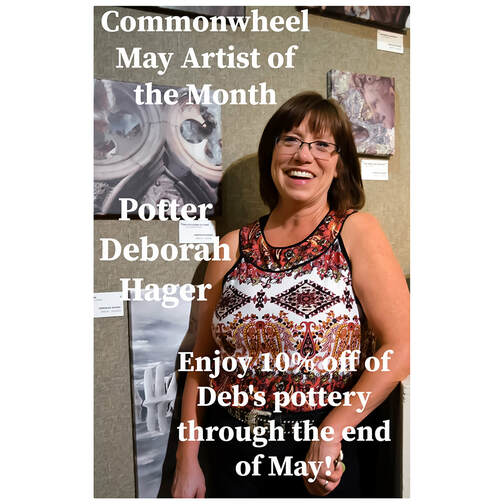







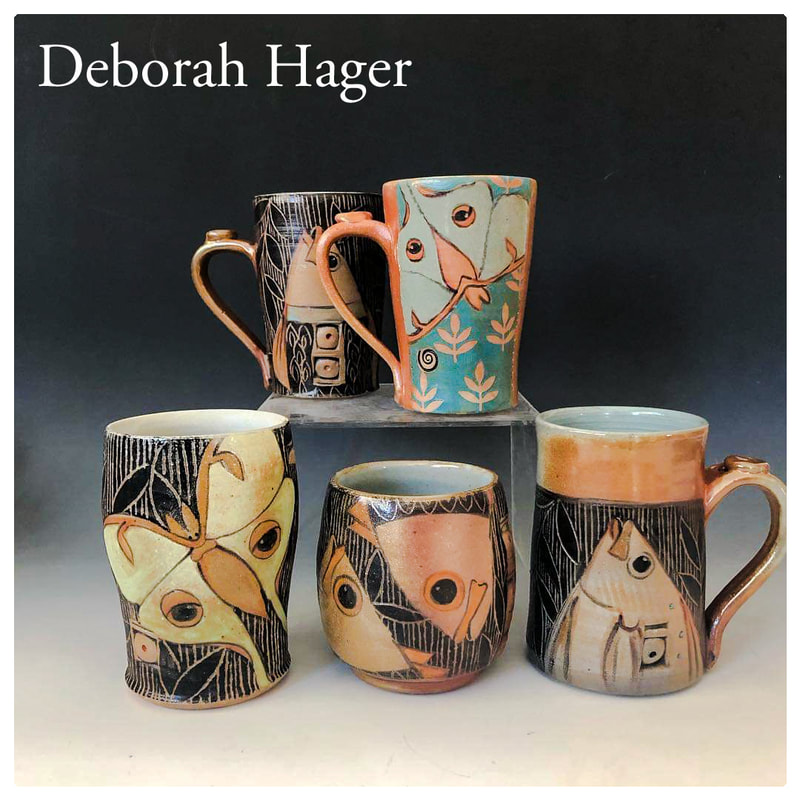




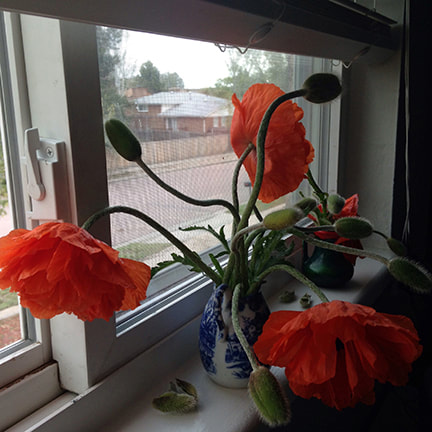




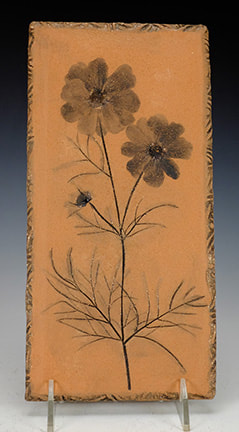





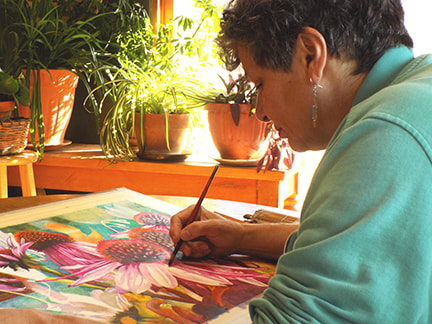

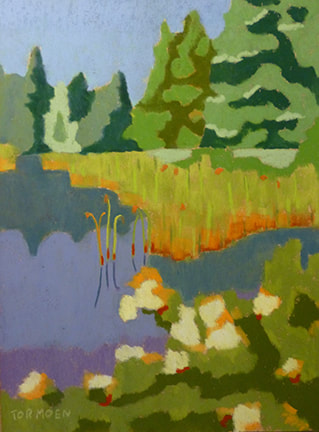
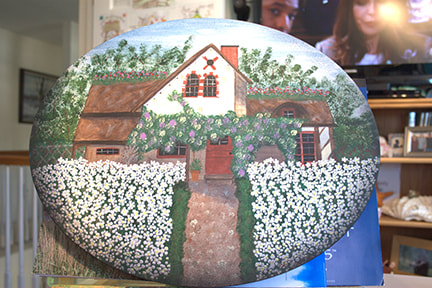

 RSS Feed
RSS Feed